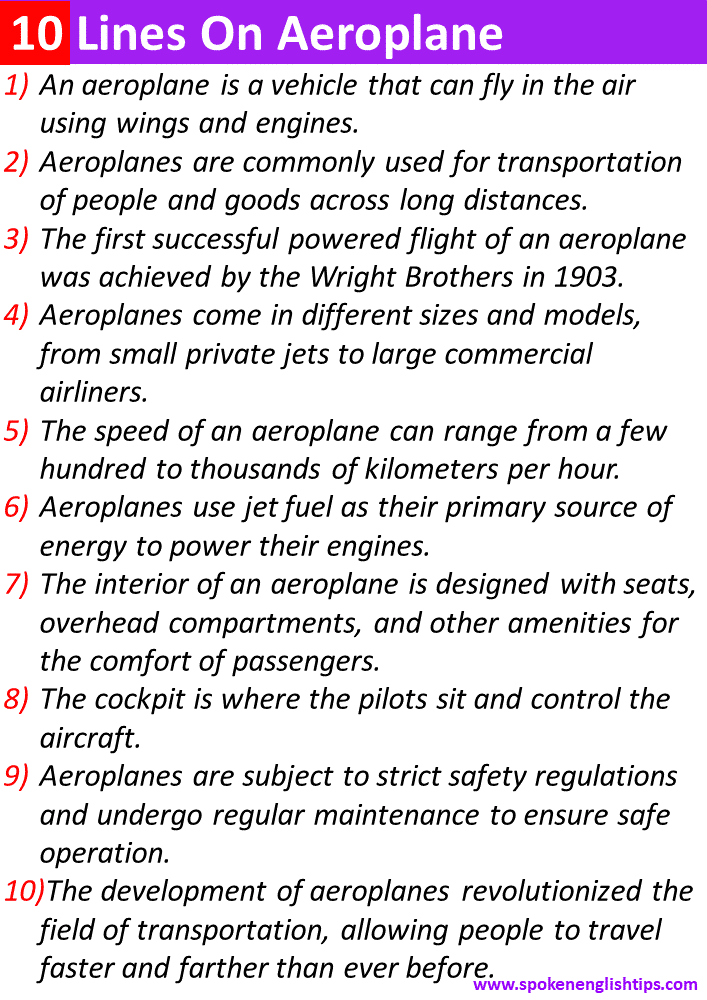In this post, I gonna share with you “10 Lines On Aeroplane“. This article is especially for those students who are seeking more information about the ten Lines On Aeroplane. This essay is very easy to remember for students. We have shared with you all levels of essays so that any students can remember and write on this topic. Generally, this article is useful for class 1 to higher classes.
10 Lines On Aeroplane
- An aeroplane is a vehicle that can fly in the air using wings and engines.
- Aeroplanes are commonly used for the transportation of people and goods across long distances.
- The first successful powered flight of an aeroplane was achieved by the Wright Brothers in 1903.
- Aeroplanes come in different sizes and models, from small private jets to large commercial airliners.
- The speed of an aeroplane can range from a few hundred to thousands of kilometres per hour.
- Aeroplanes use jet fuel as their primary source of energy to power their engines.
- The interior of an aeroplane is designed with seats, overhead compartments, and other amenities for the comfort of passengers.
- The cockpit is where the pilots sit and control the aircraft.
- Aeroplanes are subject to strict safety regulations and undergo regular maintenance to ensure safe operation.
- The development of aeroplanes revolutionized the field of transportation, allowing people to travel faster and farther than ever before.
Ten Lines on Aeroplane
| No. | Description |
|---|---|
| 1. | Aeroplanes are also used for military purposes, such as surveillance, transport, and combat. |
| 2. | The shape of the wings and the design of the engine affect the aeroplane’s speed and fuel efficiency. |
| 3. | Aeroplanes have various instruments, such as altimeters, airspeed indicators, and GPS, to aid the pilots in navigation. |
| 4. | The black box, also known as the flight recorder, records important data about the flight and can be used to investigate accidents. |
| 5. | Aeroplanes are equipped with emergency equipment, such as life jackets and oxygen masks, in case of an emergency. |
| 6. | The noise pollution caused by aeroplanes has led to concerns about its impact on the environment and human health. |
| 7. | Some aeroplanes are designed to be supersonic, meaning they can travel faster than the speed of sound. |
| 8. | The Boeing 747, also known as the jumbo jet, is one of the most popular and recognizable commercial airliners in the world. |
| 9. | Aeroplanes undergo rigorous safety checks and inspections before every flight to ensure they are airworthy. |
| 10. | The aviation industry is constantly evolving, with new technologies and innovations being developed to make aeroplanes safer, faster, and more efficient. |
An aeroplane, also known as an airplane, is a type of vehicle that can fly in the air using wings and engines.
The development of aeroplanes revolutionized the field of transportation, allowing people to travel faster and farther than ever before. Aeroplanes come in different sizes and models, from small private jets to large commercial airliners.
The interior of an aeroplane is designed with seats, overhead compartments, and other amenities for the comfort of passengers.
The cockpit is where the pilots sit and control the aircraft. The speed of an aeroplane can range from a few hundred to thousands of kilometres per hour.
Aeroplanes use jet fuel as their primary source of energy to power their engines.
The shape of the wings and the design of the engine affect the aeroplane’s speed and fuel efficiency.
Aeroplanes have various instruments, such as altimeters, airspeed indicators, and GPS, to aid the pilots in navigation.
The black box, also known as the flight recorder, records important data about the flight and can be used to investigate accidents. Aeroplanes are equipped with emergency equipment, such as life jackets and oxygen masks, in case of an emergency.
Some aeroplanes are designed to be supersonic, meaning they can travel faster than the speed of sound.
Aeroplanes are not only used for transportation of people and goods across long distances but also for military purposes, such as surveillance, transport, and combat.
The noise pollution caused by aeroplanes has led to concerns about its impact on the environment and human health.
Therefore, the aviation industry is constantly evolving, with new technologies and innovations being developed to make aeroplanes safer, faster, and more efficient.
In conclusion, the aeroplane has had a profound impact on human society, enabling us to connect with people and places that were once inaccessible.
The development of this amazing technology has brought us closer together, expanding our horizons and opening up new possibilities for travel and exploration.

Read Also: